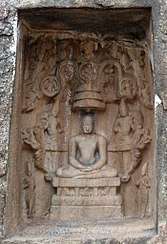Kalugumalai Jain Beds
Kalugumalai Jain beds in Kalugumalai, a panchayat town in Thoothukudi district in the South Indian state of Tamil Nadu, are dedicated to the Jain and Hindu religious figures. Constructed in rock cut architecture, the unfinished temple is believed to have been built during the reign of Pandyan king Parantaka Nedunjadaiya (768-800 CE). The rock-cut architecture at Kalugumalai is an exemplary specimen of Pandyan art. The other portions of Kalugumalai houses the 8th century unfinished Shiva temple, Vettuvan Koil and Kalugasalamoorthy Temple, a Murugan temple at the foothills.
| Kalugumalai Jain Beds | |
|---|---|
.jpg) Kalugumalai Jain Beds | |
| Religion | |
| Affiliation | Jainism |
| Location | |
| Location | Kalugumalai, Thoothukudi, Tamil Nadu |
 Location in Tamil Nadu | |
| Geographic coordinates | 9°09′02″N 77°42′15″E |
| Architecture | |
| Style | Pandyan |
| Creator | King Parantaka Nedunjadaiya |
| Date established | 8th century |
| Materials | Rock cut |
| Website | |
| kalugumalaitemple | |
There are approximately 150 niches in the bed, that includes images of Gomateshwara, Parshvanatha and other Tirthankaras of the Jainism. The Jain beds are maintained and administered by Department of Archaeology of the Government of Tamil Nadu as a protected monument.
History
The temple is believed to have been built during 8th century around 800 AD during the reign of Pandya king Parantaka Nedunjadaiya (768-800 CE).[1] Historians believe that the rock cut carvings and the caves are indicative of dwelling of Digambara sect of Jainism in the region. During modern times, some of the Digambaras attempted replacing the idol of Murugan in the lower cave temple with that of Mahavira.[2] The inscriptions in the bed indicate the position of Jain religious women in the society compared to their male counterparts. There are women higher in the monastic order and they travelled to lot of places. There are twenty one religious places mentioned where these women travelled, out of which eleven have been deciphered - one being Kalugumalai itself, five in Ramanathapuram district, one in Tirupanthuruthi in Kanchipuram district, four in Tirucheranm in Kanyakumari district.[3] Some historians believe that Jains promoted education during the early Pandyan Empire. It is understood from the inscriptions that the Pandyan rulers developed an education centre like a Jain University near Kanyakumari exclusively for women. This led to the conclusion that Jainism had more influence on the people in the region than Buddhism. As per the inscriptions, there were around 8,000 Jains living in the regions around Madurai.[4]
The hill was under the control of Ettaiyapuram Zamindar until 1954. The Raja gifted the village to the Kalugasalamoorthy Temple and formed five streets around the temple to enable the temple car to pass easily. He also allocated a middle street for the temple priests. During the Panguni Uthiram festival procession, the elongated conflict between two castes in the region, namely, Nadars and Maravars resulted in a riots, popularly called Kalugumalai riots of 1895. A total of ten people were killed, many injured and the temple car and other property in the region were destroyed. The sculptures in Kalugumalai Jain beds and the Jain abode were not affected during the riots.[5]
Architecture
The temple is in Kalugumalai, a rocky hill in Thoothukudi district in southern Tamil Nadu. The sculptures and the carvings are indicative of Pandyan art during the period.[1] The granite rock looks like a blooming lotus, with hills surrounding it on three sides.[6][7]
There are approximately 150 niches in the bed, that includes images of Gomateshwara, Parshvanatha and other Tirthankaras of the Jainism.[1]
Culture
Kalugumalai Jain beds is maintained and administered by Department of Archaeology of the Government of Tamil Nadu as a protected monument.[8] Kalugumalai was chosen in the plan to be included as a rural tourism site in Incredible India campaign by the Tourism Ministry of the Government of India.[9] As a part of the campaign the ministry allocated ₹10 million to develop the infrastructure around the region in 2008. The tourist inflow to the town increased to 3,000 persons per month during 2009 from 400 per month during the previous years.[10]
Gallery
- Gommaṭeśvara
 Jain reliefs
Jain reliefs.jpg) Jain reliefs
Jain reliefs.jpg) Jain reliefs
Jain reliefs.jpg) Jain reliefs
Jain reliefs.jpg) Jain reliefs
Jain reliefs.jpg) Jain reliefs
Jain reliefs.jpg) Jain reliefs
Jain reliefs
References
Citation
- "Sthala Varalaru". Hindu Religious and Endowment Board, Government of Tamil Nadu. 2015. Retrieved 4 November 2015.
- Dundas 2003, p. 125–6.
- Orr (1998). "Open boundaries". In Cort, John E. (ed.). Open Boundaries: Jain Communities and Cultures in Indian History. SUNY Press. pp. 198–99. ISBN 9780791437858.
- B.S., Chandrababu (2011). History of People and Their Environs: Essays in Honour of Prof. Bharathi Puthakalayam. p. 70. ISBN 9789380325910.
- Good, Anthony. "The Car and the Palanquin: Rival Accounts of the 1895 Riot in Kalugumalai, South India". Modern Asian Studies. Cambridge University Press. 33 (1): 23–65. doi:10.1017/s0026749x99003200. JSTOR 313150.
- "Kazhugumalai deserves universal recognition". Tuticorin: The Hindu. 8 August 2012. Retrieved 4 November 2015.
- Virupa, Kumaresan, ed. (2014). பல்நோக்குப் பார்வையில் முருகத் தத்துவம் II: Proceedings of the International Conference on Murugabhakthi 2014. Thirumurugan Thiruvakku Thirupeedam. p. 1047.
- "Protected Monuments under the control of the Department". Department of Archaeology, Government of Tamil Nadu. 2011. Retrieved 4 November 2015.
- "14 more rural tourism sites to be ready". New Delhi, India: Hindustan Times. 29 May 2008. Archived from the original on 9 April 2016. Retrieved 4 November 2015 – via HighBeam Research.
- "Tourism shoots up in picturesque Tamil temple town". New Delhi, India: Hindustan Times. 1 January 2009. Archived from the original on 18 October 2016. Retrieved 4 November 2015 – via HighBeam Research.
Sources
- Dundas, Paul (2003). The Jains. Routledge. ISBN 9781134501656.


.jpg)
.jpg)
